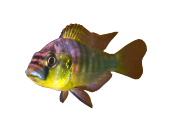Pollen AA, Dobberfuhl AP, Scace J, Igulu MM, Renn SCP, Shumway CA, Hofmann HA.
Environmental complexity and social organization sculpt the brain in Lake Tanganyikan cichlid fish. Brain, Behavior and Evolution. 70 (1) :21 - 39.
AbstractComplex brains and behaviors have occurred repeatedly within vertebrate classes throughout evolution. What adaptive pressures drive such changes? Both environmental and social features have been implicated in the expansion of select brain structures, particularly the telencephalon. East African cichlid fishes provide a superb opportunity to analyze the social and ecological correlates of neural phenotypes and their evolution. As a result of rapid, recent, and repeated radiations, there are hundreds of closely-related species available for study, with an astonishing diversity in habitat preferences and social behaviors. In this study, we present quantitative ecological, social, and neuroanatomical data for closely-related species from the (monophyletic) Ectodini clade of Lake Tanganyikan cichlid fish. The species differed either in habitat preference or social organization. After accounting for phylogeny with independent contrasts, we find that environmental and social factors differentially affect the brain, with environmental factors showing a broader effect on a range of brain structures compared to social factors. Five out of seven of the brain measures show a relationship with habitat measures. Brain size and cerebellar size are positively correlated with species number (which is correlated with habitat complexity); the medulla and olfactory bulb are negatively correlated with habitat measures. The telencephalon shows a trend toward a positive correlation with rock size. In contrast, only two brain structures, the telencephalon and hypothalamus, are correlated with social factors. Telencephalic size is larger in monogamous species compared to polygamous species, as well as with increased numbers of individuals; monogamy is also associated with smaller hypothalamic size. Our results suggest that selection or drift can act independently on different brain regions as the species diverge into different habitats and social systems. Copyright © 2007 S. Karger AG.
 2007.pollen.bbe_.pdf
2007.pollen.bbe_.pdf Aubin-Horth N, Desjardins JK, Martei YM, Balshine S, Hofmann HA.
Masculinized dominant females in a cooperatively breeding species. Molecular Ecology. 16 (7) :1349 - 1358.
AbstractThe molecular mechanisms underlying complex social behaviours such as dominance are largely unknown. Studying the cooperatively breeding African cichlid Neolamprologus pulcher, we show that dominant females were similar to dominant males in dominance behaviour, high testosterone levels and brain arginine vasotocin expression (a neuropeptide involved in vertebrate territorial, reproductive and social behaviours) compared to subordinate helpers, but had lower levels of 11-ketotestosterone than males. Furthermore, brain gene expression profiles of dominant females were most similar to those of the males (independent of social rank). Dominant breeder females are masculinized at the molecular and hormonal level while being at the same time reproductively competent, suggesting a modular organization of molecular and endocrine functions, allowing for sex-specific regulation.
 2007.aubin-horth.me_.pdf
2007.aubin-horth.me_.pdf Shumway CA, Hofmann HA, Dobberfuhl AP.
Quantifying habitat complexity in aquatic ecosystems. Freshwater Biology. 52 (6) :1065 - 1076.
AbstractSummary 1. Many aquatic studies have attempted to relate biological features, such as species diversity, abundance, brain size and behaviour, to measures of habitat complexity. Previous measures of habitat complexity have ranged from simple, habitat-specific variables, such as the number of twigs in a stream, to quantitative parameters of surface topography, such as rugosity. 2. We present a new video-based technique, called optical intensity, for assaying habitat complexity in aquatic ecosystems. Optical intensity is a visual, quantitative technique modifiable for any scale or for a nested analysis. We field-tested the technique in Lake Tanganyika, Tanzania, on 38 quadrats (5 x 5 m) to determine if three freshwater habitats (sand, rock and intermediate) were quantitatively different. 3. A comparison of the values obtained from optical intensity with a previous measure of surface topography (rugosity) showed that the two corresponded well and revealed clear differences among habitats. Both the new measure and rugosity were positively correlated with species diversity, species richness and abundance. Finally, whether used alone or in combination, both measures had predictive value for fish community parameters. 4. This new measure should prove useful to researchers exploring habitat complexity in both marine and freshwater systems.
 2007.shumway.fb_.pdf
2007.shumway.fb_.pdf Trainor BC, Hofmann HA.
Somatostatin and somatostatin receptor gene expression in dominant and subordinate males of an African cichlid fish. Behavioural Brain Research. 179 (2) :314 - 320.
AbstractSomatostatin is a neuropeptide best known for its inhibitory effects on growth hormone secretion and has recently been implicated in the control of social behavior. Several somatostatin receptor subtypes have been identified in vertebrates, but the functional basis for this diversity is still unclear. Here we investigate the expression levels of the somatostatin prepropeptide and two of its receptors, sstR2, and sstR3, in the brains of socially dominant and subordinate Astatotilapia burtoni males using real-time PCR. Dominant males had higher somatostatin prepropeptide and sstR3 expression in hypothalamus compared to subordinate males. Hypothalamic sstR2 expression did not differ. There were no differences in gene expression in the telencephalon. We also observed an interesting difference between dominants and subordinates in the relationship between hypothalamic sstR2 expression and body size. As would be predicted based on the inhibitory effects of somatostatin on somatic growth, sstR2 expression was negatively correlated with body size in dominant males. In contrast sstR2 expression was positively correlated with body size in subordinate males. These results suggest that in A. burtoni social status affects the relationships between somatostatin prepropeptide and receptor gene expression in the hypothalamus and the control of somatic growth. ?? 2007 Elsevier B.V. All rights reserved.
 2007.trainor.bbr_.pdf
2007.trainor.bbr_.pdf 
